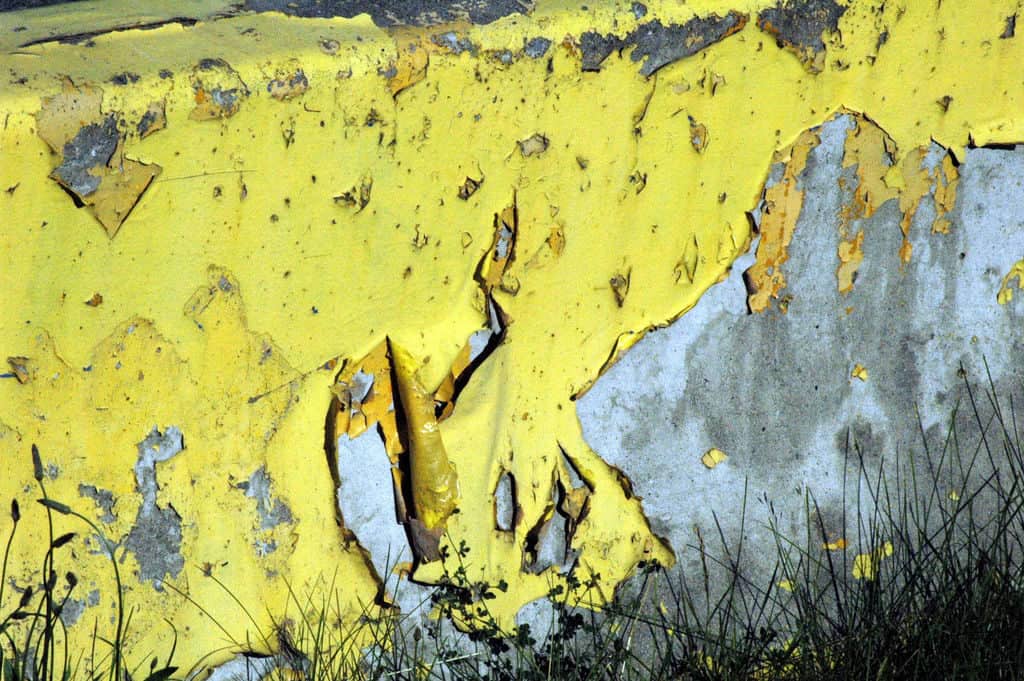| While it’s hard to put an exact price tag on what concrete-floor coating failures cost building owners, contractors and retailers each year, two things are clear.
First, these failures, nearly all of them avoidable, happen a lot. Second, if it happens to you, it costs too much. Concrete is a complex material and many issues need to be addressed for coating applications to succeed. In newly poured floors, for example, factors such as high pH levels as well as excessive moisture can cause coatings failure. On existing concrete floors, however, the most common reason for coating failure is excessive moisture content. Testing for MoistureMoisture is a problem when it is present in excess within the concrete or from an outside source, such as poor drainage from outside the building. The pressure of the rising moisture makes perfectly good coatings blister and delaminate, sometimes within weeks of application. While few people are clueless enough to coat an obviously wet concrete floor, the problem is that you can’t identify a floor with excessive moisture levels just by looking. Concrete slabs set for coating should always be tested for moisture, even when they look dry. Many people don’t, and that’s one reason failures occur. There are various tests for moisture, including the plastic sheet method, calcium chloride test, relative humidity measurement (within the concrete slab) and various moisture meters. The choice of method should be consistent with project specifications and the coating manufacturer’s requirements. Here’s a quick look at test methods for determining if floors are dry enough to coat. Plastic sheet method: This test is conducted in accordance with ASTM D4263 Standard Test Method for Indicating Moisture in Concrete by the Plastic Sheet Method. Tape an 18-square-inch (116-square-centimeter) plastic sheet to the floor and keep it in place 16 to 24 hours. If moisture has condensed on the underside of the sheet, your coating will likely be at risk. Calcium chloride test: This test determines concrete’s vapor emission rate in accordance with ASTM F1869 Standard Test Method for Measuring Moisture Vapor Emission Rate of Concrete Subfloor Using Anhydrous Calcium Chloride. The test involves placing a measured amount of anhydrous calcium chloride under a sealed dome on the slab surface for 60 to 72 hours. Weight increase after the test period is attributed to moisture, and the vapor emission rate is calculated in pounds per 1,000 square feet (92 square meters) per 24 hours.
The method specifies three test locations for up to 1,000 square feet and one test per each additional 1,000 square feet. Relative humidity: This test is conducted in accordance with ASTM F2170 Standard Test Method for Determining Relative Humidity in Concrete Floor Slabs Using in situ Probes. Drill holes in the floor to 40 percent of the slab thickness (for an on-grade slab). Place a plastic sleeve or hole liner in the hole and cap it, leaving the bottom open. After 72 hours, when it is assumed the space within the sleeve has reached equilibrium, insert a relative humidity probe or sensor into the sleeve to get the measurement. This method specifies three test locations for up to 1,000 square feet and one test per each additional 1,000 square feet. Moisture meters: There are various moisture meters for concrete; however, measurements are generally considered to give relative levels of moisture rather than quantitative moisture values. Some moisture meters operate by measuring the resistance between the tips of two insulated pins (which may contact nails driven into the surface) and converting the resistance value into a relative moisture content. Other meters have contacts that rest on the concrete surface (i.e., are non-destructive) and measure electrical impedance, converted to a relative moisture content. For moisture values from meters to be reliable on specific projects, coating manufacturers must supply limits for specific meters in project specifications. The most commonly specified and performed tests are the calcium chloride and relative humidity tests. General guidance for acceptable results for both tests is provided by ASTM F710 Standard Practice for Preparing Concrete Floors to Receive Resilient Flooring. ASTM F710 states a maximum of 3 pounds per 1,000 square feet per 24 hours for vapor emission (calcium chloride) and 75 percent maximum for relative humidity, if other criteria are not otherwise specified or provided by the coating material manufacturer. Though ASTM F710 specifically applies to resilient flooring, the method also states the procedures may be useful for preparing concrete floors to receive other finishes such as coatings. It’s important to condition the space to the temperature and humidity levels it will have when finished for at least 48 hours before testing. If testing reveals high moisture content, you have two options: You can try to mitigate the conditions causing the moisture and let the floor dry, or you can use a coating specifically made for higher moisture levels. Preparing Concrete for CoatingOnce you’ve gotten acceptable moisture results from the floor for your coating, you can prepare the concrete surface. Surfaces must be intact and sound. Fill cracks, spalls and voids with appropriate concrete repair material. The repair materials must be intended for concrete and appropriate for the service environment. For example, any acrylic-based repair or patching products for concrete should generally consist of 100 percent acrylic resin, which can withstand moisture (and some pH) exposure. Once repairs are made, remove contaminants from the concrete surface. Products specifically made for cleaning concrete are the best choice, since they’ll generally address the difficulty of cleaning the porous surface. Here’s a look at a few common methods. Abrasive blast cleaning: The goal is to roughen the surface without causing damage or gouging that might require repairs.
Concrete floor blast cleaning is often performed using walk-behind self-contained centrifugal wheel blast units that use a vacuum system to contain the abrasive and debris. These units are well-suited for large concrete floors.
Abrasive blasting is easily capable of removing the top layer of concrete, as well as contaminants, so use this method carefully. Pressurized water cleaning: High-pressure water cleaning, with or without proprietary cleaners, is effective at removing water-soluble contaminants and weak concrete. Like abrasive blasting, there’s potential for damaging the surface if pressure is too high, the nozzle is too close to the surface, or both, so be careful. If your floor has excessive moisture issues, consider that pressure washing can add to the moisture load in the concrete. Acid etching: Reaction of acid with the alkaline concrete surface removes the outer layer of concrete, etching the surface. The concrete must first be free of coatings, sealers or waterproofing materials, grease, oil or other contaminants. Appropriate acids include hydrochloric (muriatic), sulfuric, phosphoric or citric acid. Acid etching requires thorough cleaning and rinsing to remove the excess acid and reaction products. Scrubbing may be required for complete removal. Leaving excess acid and byproducts in place will likely cause coating failure. Safety gear, including skin, eye and respiratory protection, are crucial when using acid. The specified method must be appropriate for the selected coating and consistent with any requirements of the coating manufacturer. Generally, sealer and stain products will require a clean surface but do not need a roughened surface. Coating products that form thicker films on the concrete require roughened surfaces.
Selecting the Stain, Dye or CoatingA variety of stains, dyes and coatings are available for concrete floors and can function well, but attention to detail is important in selecting proper materials and specifying the work. Stains and Dyes: Stains are typically acid-based materials that function, in part, by reacting with the concrete in creating the desired surface appearance. Stains do not leave a measureable film on the surface and may have a higher moisture tolerance than a film-forming coating. Moisture limits provided by the manufacturer should be followed for the stains to perform as intended. Dyes are similar to stains but generally do not react with the concrete after application. They are usually water- or solvent-based. The same cautions for moisture limits apply. Coatings: Aside from stains and dyes, there are a variety of film-forming coatings for concrete, including acrylics, epoxies, polyurethanes, polyureas and polyurethane/polyurea hybrids. The typical surface required is clean and sound concrete. For most coatings the concrete surface needs some degree of roughening. Acrylic coatings are single-component materials that are typically applied at 2 to 3 mils per coat. Acrylic coatings usually comprise a two- or three-coat system including a primer and one or two finish coats. Acrylics provide moderate performance but may not be the best choice where heavy wear is expected, such as in heavy commercial or industrial locations. Epoxy coatings may be the most widely used coatings for concrete floors. They see broad use in spaces from school lunchrooms to hospital operating rooms to auto repair bays. A variety of epoxy coatings are available, including solvent and waterborne formulations. Epoxies are multi-component coatings with good abrasion resistance and moderate to excellent chemical resistance. Polyurethanes are multi-component materials with good abrasion resistance and moderate chemical resistance. They’re also used in a variety of settings similar to where you might find epoxies. Typical polyurethanes are applied in one or two coats at just a few mils per coat. A polyurethane coating may be applied as a topcoat over an epoxy coating where sunlight or weathering is an issue. Single-component polyurethane coatings can also be formulated using moisture-curing polyurethane resins. These resins contain functional groups that react with moisture in the environment to form the cured coating film. Moisture-curing polyurethanes offer nearly the same performance properties as multi-component polyurethanes with the obvious advantage of a single pack product. Thicker-film polyurethanes, which are high or 100 percent solids multi-component materials, are available for specialized applications where increased chemical resistance is required. Similar to the thicker-film epoxies, these coatings cure quickly and may require specialized application equipment. Roughening of the surface by mechanical abrasion methods is required for these coatings. Polyurea coatings most often refer to thick-film coatings that require specialized application equipment, cure very quickly and offer excellent chemical resistance. They’re often found in industrial settings or locations where chemical exposures are expected. Polyureas are similar to 100 percent solids polyurethanes but cure faster. Application is less affected by ambient conditions such as moisture, but the faster cure can also make achieving adequate adhesion to the substrate a challenge. Roughening surfaces by mechanical abrasion is required for polyureas. Hybrids generally refer to polyurethane/polyurea coatings, formed by combining the two resin types, producing a coating with the best features of each. The properties, application and surface-preparation requirements will generally be the same as for the thick-film 100 percent solids polyurethane and polyurea coatings. For any of the thick-film coatings requiring specialized application equipment, applicators should be trained and may need to be certified/licensed by the coating manufacturer. Despite the high failure rate of concrete floor coatings, it’s possible to achieve consistently great results on existing slabs. You just have to be aware that there are no shortcuts. Every stage, from testing to surface preparation to coating application, has its own issues and considerations. Therein lie the keys to both failure and success. About the AuthorJayson Helsel is a senior coatings consultant with KTA-Tator Inc. He is a registered professional engineer, an SSPC protective coatings specialist, an SSPC-certified concrete coatings inspector and a NACE-certified coatings inspector. At KTA, Helsel manages coating projects, performs failure investigations and coating surveys, writes coating specifications and is a regular instructor for coating inspection courses. He holds a master’s degree in chemical engineering from the University of Michigan. Durability + Design: Building Performance And Aesthetics ©2014 Technology Publishing Company |







